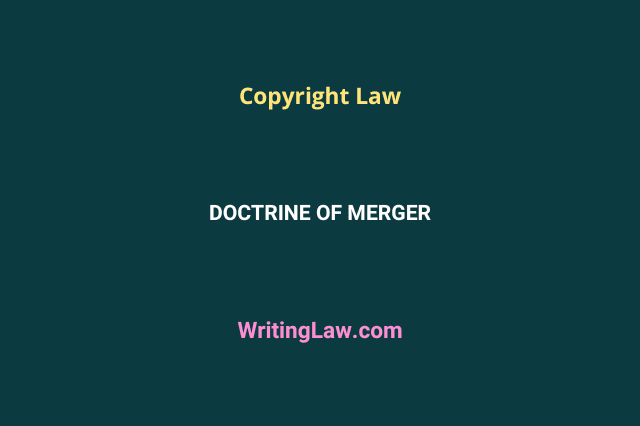
The doctrine of merger is a well-established concept under the common law system. This concept aims to solve the problems brought on by the fusion of an idea and its expression in work. To determine the restrictions of the copyright law, this concept is used in accordance with the Idea-Expression Dichotomy.
One of the essential tenets of copyright law is that the expression of an idea (rather than just the idea itself) receives copyright protection. This means that copyright only protects how ideas are presented; it does not protect concepts, facts, ideas, or systems.
In several cases, including one of the significant judgements in R.G Anand vs M/S. Delux Films & Ors, the courts have upheld the same position. In this case, the issue arose from the similarity between two movie scripts based on the same idea. The court ruled that ideas themselves are not covered under copyright law.
Copyright protection extends to the expression of an idea rather than the idea itself. This means that while two works may have a similar underlying concept or idea, they can still be considered original and eligible for copyright protection if their specific expressions, such as the plot, characters, dialogue, or other creative elements, differ significantly.
Understanding the Doctrine of Merger
Copyright law says that ideas themselves cannot be protected. So, when a work combines an idea with its expression, it can create a tricky situation. This happens when there’s only one specific way to express that idea.
The main goal of copyright law is to encourage creativity and innovation in society. But if we protect the expression of an idea that has no other practical way of being expressed, it could block creativity and limit how that idea is expressed in the future.
To avoid this problem, courts have stated that when an idea and its expression are so closely connected that they can’t be separated, the expression won’t be protected by copyright. This ensures that copyright laws do not control or restrict certain creative ideas. It allows more freedom for people to express those ideas in different ways without any barriers.
Therefore, the courts have ruled that these works will not be covered by copyright protection since granting copyright protection to these expressions would go against the copyright’s fundamental purpose. When deciding whether to protect an expression, courts consider whether the idea and the expression are closely related.
Case Laws on the Doctrine of Merger
The doctrine of merger has been recognised by courts worldwide in several decisions. In the case Herbert Rosenthal Jewellery Corporation vs Kalpakian, the court determined that a piece of bee-shaped pin jewellery cannot be protected by copyright because it is covered by the doctrine of merger since the idea of the bee-shaped pin can only be conveyed in a singular form.
In a different case involving the concept of video games, Affiliated Hospital Products vs Merdel Game Manufacturing Co., the court determined that conceptual similarities across video games cannot be protected by copyright since this idea may only be conveyed in a certain way.
The Indian Courts have also mentioned the doctrine of merger. The court ruled in the case of Chancellor Masters & Scholars vs Narendra Publishing House that mathematical statements cannot be protected by copyright since the mathematical expression can only be expressed in numerical form; it is covered under the doctrine of merger.
The question in Morrisey vs Proctor & Gamble Co. was whether the competition’s rules should be given copyright protection. The court determined that because the competition’s rules and concepts are intertwined, awarding copyright protection to the regulations would also extend copyright protection to the competition’s concept as a whole. As a result, rules are not protected by copyright.
The dispute in Joshua Et-Hokin vs Skyy Spirits Inc. concerned several images of Skyy Spirits’ recognisable blue bottle. The judge ruled that copyright cannot be granted because there are just a few possible angles for photographing the bottle.
In the case of Mattel, Inc. & Ors. vs Mr. Jayant Agarwalla & Ors., the Delhi High Court provided further clarification on the doctrine of merger. The court stated that copyright protection cannot be granted if an idea and its expression are so closely intertwined that they become inseparable. Giving copyright in such cases would essentially create a monopoly over the underlying idea.
The doctrine of merger has been used by courts around the globe to decide whether to give copyright protection in various instances. Examples are jewellery designs, video game ideas, mathematical formulas, competition rules, and even photographs of specific things. In every case, the courts have ruled that copyright protection cannot be given when an idea and its expression cannot be separated and there are no acceptable ways to convey that idea.
In a nutshell, the concept of merger is a protection given under copyright law that strikes a balance between conserving the public domain of ideas and protecting original expressions. It preserves the core premise that copyright safeguards how ideas are represented rather than the ideas themselves, promoting a thriving and varied creative system.
Read Next: What Is Copyright Infringement and Its Remedies in India
- What Is Misappropriation of Trade Secrets and Its Defences? - 15th May 2024
- 7 Important Types of Mediation Briefly Defined - 14th May 2024
- Whirlpool India vs Videocon Industries – Case Explained - 13th May 2024







